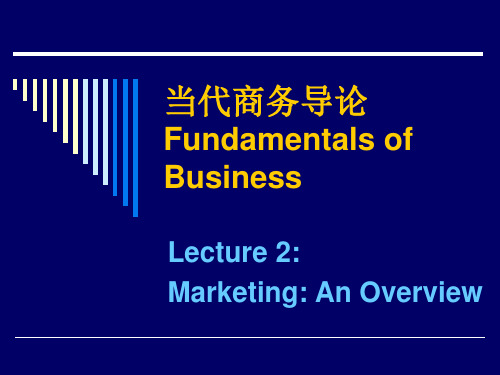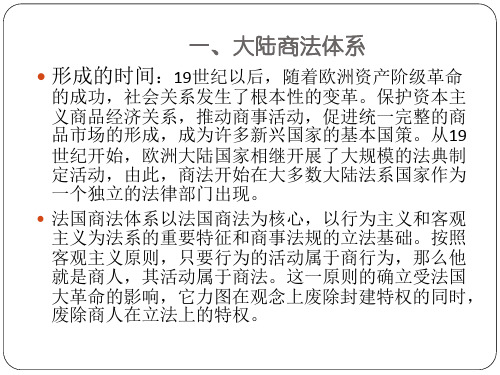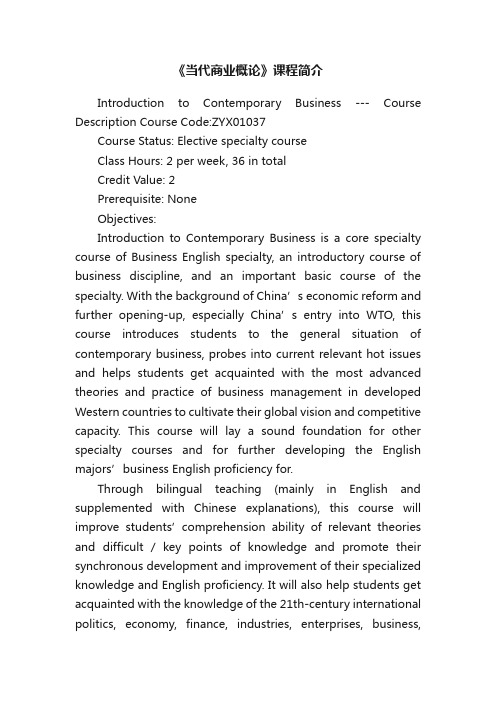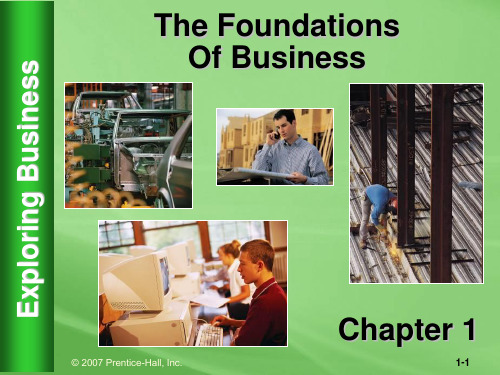当代商学概论 1
现代商学概论

智慧商祖——白圭(前463年———前385年)
• 白圭,名丹,战国东周洛阳人,梁(魏)惠王时 在魏国做官,后来到齐国、秦国。《汉书》中说 他是经营贸易发展生产的理论鼻祖,即“天下言 治生者祖”,先秦时商业经营思想家,同时他也 是一位著名的经济谋略家和理财家。诸如“人弃 我取”、“知进知守”等经商理论至今对现代理 财有指导意义。
第三业 商业
• 一、什么商业 • 是以货币为媒介进行交换从而实现商品的流 通的经济活动。商业有广义与狭义之分。广 义的商业是指所有以营利为目的的事业;而 狭义的商业是指专门从事商品交换活动的营 利性事业。
• 中国古代商业发展
• 商业兴起于先秦时期
• 秦汉时期商业初步发展
• 隋唐时期商业进一步发展 • 两宋时期商业繁荣 • 元代商业继续繁荣 • 明清徽商与晋商
现代商业观念
• 1.大商业:是指包括多种所有制和多种形式的 社会商业—包括了物资和外贸—还指大型商业 • 2.大流通:大规模流通—大范围流通—发达流 通体系
• 商务部一定要打破内外贸分割、部门垄断、地区封 锁、管办不分的格局,为建立全国大市场创造条件。
• 3.大市场:市场商品量大、规模大—区域大— 结构功能和机制
儒商鼻祖——端木子贡(前520——?)
• 端木赐,字子贡,名赐,姓端木.春秋末期卫国人,今属河南省鹤 壁市浚县。是孔门七十二贤之一,也是“孔门十哲”之一。 子贡虽出儒门,却懂经商之术。多年的经商活动使他积累 了大量的财富,这为孔子与其门徒的周游列国活动提供了 有力的经济保障,历史上多用“端木遗风”来表经商致富 之人,即源于此。孔子曾称其为“瑚琏之器”(古代宗庙 中盛生黍的祭器,常用来比喻有立朝执政才能的人)。他 利口巧辞,善于雄辩,且有干济才,办事通达。曾任鲁、 卫两国之相。为孔子弟子中首富。
当代商业概论 Fundamentals of Business

Marketing is:
-- finding the needs of the customers and satisfying them at a profit -- how you design and define your products, distribute your products, promote your products, and maintain a relationship with your customers -- the process of planning and executing the conception, pricing, promotion, and distribution of ideas, goods, and services to create exchanges that satisfy individual and organizational objectives (Source: The American Marketing Association, Marketing News, September 15, 2004, p.17)
Task 1: Definition of a marketing mix
Decisions about marketing involves strategies for four areas of marketing activities: production, distribution, promotion, and pricing. A firm’s marketing mix blends the four strategies that fit the needs and preferences of a specific target market. Marketing success depends not on the four individual strategies, but on the unique combination.
商学概论复习题

商学概论复习题商学概论复习题商学概论是一门涵盖广泛的学科,它涉及到经济学、管理学、市场学等多个领域。
学习商学概论的目的是为了了解商业运作的基本原理和规律,培养学生的商业思维和管理能力。
下面是一些商学概论的复习题,希望能帮助大家巩固知识。
1. 商业环境是指商业活动所处的外部环境。
请简要介绍商业环境的组成部分。
商业环境由宏观环境和微观环境组成。
宏观环境包括经济环境、政治环境、社会文化环境和技术环境等。
经济环境主要涉及国家的经济发展水平、经济政策和市场竞争状况等。
政治环境则与国家的政治体制、政策法规和政府行为有关。
社会文化环境包括社会价值观念、文化传统和社会习俗等。
技术环境则指科技水平和创新能力。
微观环境主要指商业活动中的各个参与者,包括供应商、顾客、竞争对手和中间商等。
供应商是提供产品和服务的企业或个人,顾客则是购买产品和服务的个人或企业。
竞争对手是同一行业中的其他企业,中间商则是连接供应商和顾客的商业中介。
2. 请解释市场需求和市场供给的概念,并说明它们之间的关系。
市场需求是指在一定时间内,消费者愿意购买某种产品或服务的数量。
它受到多种因素的影响,包括价格、收入、个人偏好和市场趋势等。
市场需求曲线通常呈现下降趋势,即价格上升时需求量减少,价格下降时需求量增加。
市场供给是指在一定时间内,供应商愿意提供某种产品或服务的数量。
它也受到多种因素的影响,包括生产成本、技术水平和市场竞争等。
市场供给曲线通常呈现上升趋势,即价格上升时供给量增加,价格下降时供给量减少。
市场需求和市场供给之间存在着相互作用的关系。
当市场需求增加时,供应商会增加生产以满足需求,从而导致市场供给增加。
相反,当市场需求减少时,供应商会减少生产,导致市场供给减少。
市场需求和市场供给的平衡点称为市场均衡,即市场上需求量等于供给量的状态。
3. 请简要介绍市场细分的概念和意义。
市场细分是将整个市场划分为若干个具有相似需求和特征的小市场的过程。
市场细分可以根据不同的标准进行,如地理位置、年龄、性别、收入水平和消费习惯等。
当代商学概论 5

Promotion mix 促销组合 is: -- the combination of various promotion methods that a firm uses to persuade customers to buy its products
advertising 广告 personal selling 个人推销 sales promotion 促销活动 public relations 公共关系
How important is promotion?
Over 75% of the price of a box of washing powder goes to pay for the costs of promoting the product. $300 to $6,000 of the price of a new car is used to tell customers how excellent it is. “Our leading brands begin with world-class product technology, but it’s advertising that gets consumers’ attention and persuade them to use our products again and again. Advertising is the lifeblood of our brands. … Advertising is the key driver in all our businesses, but it’s especially important for health care products – because consumers want a brand they know and trust. Advertising helps establish the trust.” -- P&G acan you find ads of the above brands in your daily life?
当代主要商法体系

新中国成立以后,在很长一段时间内,由于实行计划经济,国 家的立法重心在于强化国家调控经济活动的能力和国家干预经 济行为的行政手段,因此,商法极不发达。1993年之前,我国 颁布了《海商法》等少数商事法律外,其它的商事立法几乎空 白,1993年之后全国人大常委会陆续制定和修订了《公司法》、 《票据法》、《合伙企业法》、《保险法》、《商业银行法》、 《证券法》、《企业破产法》等法律,商法作为一个独立的法 律部门成立。
《日本商法典》在体制上仿效法国商法,内容上则采德国 商法,在立法模式上,兼采客观主义和主观主义,既重视 商人也重视商行为,《法典》同时以商人和商行为作为立 法基础,这种立法模式又被称为折中主义模式。
二、英美商法体系
在英美法系国家,一般不存在大陆法系意义上的民法 典和商法典,因此,在这些国家,不存在民商分立或 者民商合一的问题。
法国商法体系以法国商法为核心,以行为主义和客观 主义为法系的重要特征和商事法规的立法基础。按照 客观主义原则,只要行为的活动属于商行为,那么他 就是商人,其活动属于商法。这一原则的确立受法国 大革命的影响,它力图在观念上废除封建特权的同时, 废除商人在立法上的特权。
法国商法由《法国商法典》及相关的商事法规组成,
对于我国的商法体系构建来说,要注重的商法的权威 性、实用性,具体的构建那就应该从民法合一的角度 进行,商法最终的目地是服务于民,但是又有区别于 民法的地方。对于目前我国商法的构建,在考虑到我 国经济市场发展的情况下,再应该从我国经济发展相 关的商法关系模式竞争入手,力争能够表达出商法的 创新机制和功能,同时也应该注重民法和商法立法模 式,确保我国的民法以及商法规则共同进化中商法独 立性,做好商法的构建,为我国社会经济发展做出贡 献。
商学概论课程介绍

商学院课程编号:BK课程名称:商学概论Business Essentials学分:2 总学时:34讲课:34内容提要:“商学”是关于工商企业发起筹建、组织运营、谋求良好绩效等经营管理全面流程的知识与对策体系。
商学概论是为经管类学生以及对涉及企业经营管理全程的相关知识与实务感兴趣的外专业学生开设的专业基础课程。
商学概论为后续专业课程提供一个企业的组织与运营的整体概念,因此既是商科知识体系的启蒙性课程,又是多数经管类专业课程的先导课程。
研修商学概论,对经管类专业课程的深度学习,熟识企业全面运营过程,了解经营管理要点和难点大有裨益,是诱发学生专业兴趣,促使学生进入专业角色、树立专业信念和初具专业素养的专业教育平台。
本课程的内容共分六个部分。
第一部分:“导论”,包括企业运营环境、商业伦理与社会责任、企业家精神、企业创立与所有权类型等重要内容;第二部分:“企业管理”,包括企业的组织形式、生产运营与质量体系等主要内容;第三部分:“组织中的人”,包括员工行为与激励、领导行为与决策、人力资源等主要部分;第四部分:“营销原理”,包括营销过程、消费者行为、定价、分销渠道以及促销等内容;第五部分:“信息管理”,包括商业信息技术、会计职能与会计信息等主要内容;第六部分:“金融与财务”,包括货币银行业务、财务管理等主要内容。
参考教材:《商学精要》(英文版,第8版),罗纳德·J·埃伯特(Ronald J.Ebert) , 里基·W·格里芬(Ricky W.Griffin),中国人民大学出版社,2010年。
授课对象:经济、管理类各专业及全校文科院系本科低年级学生。
先修课程:微观经济学、宏观经济学主讲教师:王真BRIEF DESCRIPTION OF UNDERGRADUATE CURRICULA COURSE CODE:BKCOURSE NAME:Business EssentialsCREDITS:2CLASS HOURS:34(THEORETICAL EDUCATION:34 ,PRACTICAL EDUCATION:0 )ABSTRACT:Business is a set of knowledge and practice those which are involved with the process of business and management, respecting to business firm planning and starting up, operation and organization, excellent performance making. Business Essentials is a fundamental course for business school students and non-business major students those whom are interesting in the knowledge and practice toward to the process of business and management. Business Essentials as an initiative course provides a globalconcept of the enterprise for students to study following specialized courses. It is an important educational platform for students to acquainted with business operation, inspire their academic desire, make clear the key elements and issues in business practice, cultivate the professional quality.There are six parts in this course. Part Ⅰ: Introduction. It contains business environment, business ethics and social responsibility, entrepreneurship, start-up and ownership structure. Part Ⅱ: Business Administration. It contains organizational structure, operation and quality control. Part Ⅲ: People in Organizations. It contains employee behavior and motivation, leadership and decision-making, human resources. Part Ⅳ: Principles of Marketing. It contains marketing process and consumer behavior, pricing, distributing and promoting products. PartⅤ: Managing Information. It contains information technology for business, the role of accountants and accounting information. PartⅥ: Financial Issues. It contains money and banking, managing finances.REFERENCE:Business Essentials, Ronald J. Ebert and Ricky W.Griffin, Ren Min University Press, 2010.STUDENTS:business major students and art major students from all over the campus .PREREQUISITES:Microeconomics and MacroeconomicsTEACHERS:Wang Zhen, professor。
《当代商业概论》课件

商业行为
商业决策的基本过程
商业决策是企业核心管理人员在 面临问题时的选择行为,一般包 括决策的定义、目标、方案、实 施和评估。
商业运营模式的变革
随着技术的不断发展,商业运营 模式也在不断转型,比如以物流 配送和使用物流机器人为特色的 新型商业。
商业风险管理
商业风险管理是企业面对风险时, 采取的一系列措施和管理行为, 目的是规避、转移或控制风险。
参考文献
1. 《现代商业管理》 2. 《企业经营管理》 3. 《电子商务概论》
关怀、社区参与、环境保护等方面。
商业伦理的概念与种类
商业伦理是指商业活动中所涉及的道德、 道义、正义等方面的准则和规范。常见的 商业伦理种类有诚信、公正、责任、关爱 等。
结论
1 商业的未来发展趋势
随着社会发展和科技进步,商业的未来将呈现数字化、平台化、智能化等趋势。
2 商业中应该重视的问题
商业中应该重视企业文化建设、人才队伍建设、品牌建设、社会责任等问题。
化等多个阶段的演变。
经济环境与商业
经济环境对商业的影响
宏观经济环境、市场环境、 政策环境等因素对商业的发 展都有着深刻的影响。
商业对经济环境的影响
商业的发展和壮大也会对经 济环境产生重大的影响,从 而形成一个相互作用的关系。
商业的分类与特征
商业按经营活动的商业形式 可分为批发零售业、物流仓 储业、金融保险业、建筑工 程业、信息技术业等多个类 别。
《当代商业概论》PPT课 件
欢迎来到《当代商业概论》的课程!今天我们将一起探讨商业的本质、未来 趋势以及企业如何在竞争中获得成功。
商业的定义及其发展历程
1
商业的定义
商业是指商品和服务的交换以及与其相
当代商学概论 7

An effective leader is one who can influence, persuade, and engage their followers or employees to work hard, perform well, and feel good about their job. A charismatic leader is one who is exceptionally respected by employees on a personal level, and regarded as a hero who personifies the company
Method of communication:
Letters, reports, proposals, memos, fax and email: best suited to convey the detailed, factual information that requires time and effort to digest and act upon, used at the beginning of the decision-making process FtF and telephone: most effective for persuasive communication, allow for the processing of complex information, both logical and emotional, to make the optimal decision, used at the later stages of the decision-making process
现代商学概论复习大纲1

现代商学概论复习大纲1、商品交换产生的基础答:是社会分工,商品是社会分工的产物,是为了交换而生产的产品。
社会分工是商品存在的基础。
没有社会分工,大家都生产同一样产品,就不需要进行交换,也就失去了交换的价值。
只有进行社会分工各自生产不同的产品,才有可能和有必要进行商品交换;社会分工越细、越发达交换范围和规模也越大。
2、市场与商业的关系,现代商业的特点。
市场既是商业存在的基础,又是商业赖以生存的条件。
市场是进行是进行交易活动的场所,即进行买卖的地方;其次市场属于流通领域,体现着商品、货币交换活动的总和;市场直接反映商品的需要和供应;市场从内在和外在双重的规定下制约着商业行为影响着商品流通的全过程现代商业的特点是由现代商品生产的特点所决定的,是市场经济对交换主体行为的内在要求所决定的。
一、社会性,商业过程具有社会性,商业活动制约因素具有社会性,商业活动成果具有社会性。
二、知识性,现代商业是知识商业重视整体企业和经营者的素质重视提高技术、信息在经营中的运用。
三、动态性,现代商业的整个流通过程是商流、物流、货币流、和信息流统一的动态过程。
四、复杂性,管理对象具有复杂性,管理过程具有复杂性,商业成果也具有复杂性。
3、商业与生产的关系:生产对商业起决定作用一、商业是社会再生产的中介环节,交换附属于生产,交换与生产互相决定、互为条件,交换决定生产二、生产对交换有决定作用,生产的社会分工是交换产生和发展的前提,生产为交换提供物质基础,生产方式决定交换性质,生产发展的速度、规模和结构绝对着商品交换的深度和广度,生产为提高交换手段的现代化提供物质基础。
三、交换对生产起决定作用,商品交换是商品生产存在和发展的必要条件,商品生产以商品交换为前提条件,商品交换促进社会分工的发展商品交换对商品生产具有引导作用。
4、商业与消费关系的核心由于商业活动与生产目的的一致性,决定了商业与消费关系的核心是维护消费者的利益5商业活动中的消费观念。
《当代商业概论》课程简介

《当代商业概论》课程简介Introduction to Contemporary Business --- Course Description Course Code:ZYX01037Course Status: Elective specialty courseClass Hours: 2 per week, 36 in totalCredit Value: 2Prerequisite: NoneObjectives:Introduction to Contemporary Business is a core specialty course of Business English specialty, an introductory course of business discipline, and an important basic course of the specialty. With the background of Ch ina’s economic reform and further opening-up, especially China’s entry into WTO, this course introduces students to the general situation of contemporary business, probes into current relevant hot issues and helps students get acquainted with the most advanced theories and practice of business management in developed Western countries to cultivate their global vision and competitive capacity. This course will lay a sound foundation for other specialty courses and for further developing the English majors’bu siness English proficiency for.Through bilingual teaching (mainly in English and supplemented with Chinese explanations), this course will improve students’comprehension ability of relevant theories and difficult / key points of knowledge and promote their synchronous development and improvement of their specialized knowledge and English proficiency. It will also help students get acquainted with the knowledge of the 21th-century international politics, economy, finance, industries, enterprises, business,information, etc. and the fundamentals of enterprise management, human resource management, marketing, financial affairs, etc. to lay a sound foundation for the study of more microcosmic and more detailed courses and to further increase learners’business E nglish proficiency.Course content:1) American business environment2) Business ethics and social responsibility.3) Entrepreneurship, new ventures, and business ownership.4) Global business environment5) Enterprise management6) Enterprise structure7) Operations management and quality8) Employee behavior and motivation9)Leadership and decision making10) Human resource management and labor relation11) Principles of marketing12) Management information technology13) The role of accountants and accounting information14) Money and banking15) Financial managementCourse book:R.J. Ebert & R.W. Griffin, Business Essentials (8th ed.),China Renmin University Press, 2010.Reference book:1. Boone and Kurts, Contemporary Business (14th ed.), John Wiley & Sons Inc, 2011.2. Chen Zhunmin, Fundamentals of Business, Higher Education Press, 2002.3. Charles W. Hill, International Business (5th ed.), ChinaRenmin University Press, 2006.4. Karen Collins, Exploring Business, Posts and Telecom Press, 2010.01.5. W.G. Nickels, J.M. McHugh, & S.M. McHugh, Understanding Business (11th ed.), Tsinghua University Press, 2005.6. J. Madura, Introduction to Business (4ed.), Posts and Telecom Press, 2005.01.7. Zhouy Sanduo, et al, Management—Principles and Methods (4th ed.), Fudan University Press, 2003.11.8. Zhu Wenzhong, Introduction to International Business Management (English edition)(The 11th-Five-year-Plan Projected Textbook of Guangdong University of Foreign Studies), University of International Business and Economics Press, 2007.05. Assessment:The main assignments are extracurricular reading. Every student is to read at least two articles per week, about which they will write reviews or reports. At the end of the semester, everyone is to hand in a study paper-file in which are included class notes, articles of business (including their abstracts and comments on them), analyses of the questions after the texts and summery of study methods, etc.Examination will be held in the 18th week. Seventy percent of the examination content comes from the textbook, and thirty percent from other sources.Assessment of students’ accomplishment in this course consists of various forms. Forty percent of the total score comes from the final examination and sixty percent comes from other sources: attendance (5%), class performance (20%), assignments (20%) and presentation (15%).当代商业概论1 课程编码:ZYX010372 课程性质:专业选修课3 教学时数:2学时/周,总共36学时4 学分:2学分5 先修课程:无6 教学目标与内容(300-400字):《当代商业概论》是商务英语专业的专业主干课,是一门商科的入门课程,也是商务英语专业的一门重要专业基础课程。
商学概论大一知识点

商学概论大一知识点商学概论作为商学专业的入门课程,旨在为学生介绍商业领域的基本概念、原则和理论。
本文将通过对各个知识点的论述,帮助读者了解商学概论的主要内容。
一、商学概论的定义和目的商学概论是商学专业的入门课程,旨在介绍商业领域的基本概念、原则和理论,使学生能够对商业领域有一个全面的认识。
商学概论的学习目的是培养学生的商业思维、商业素养和商业能力,为他们今后的学习和职业生涯打下基础。
二、商学概论的学科范畴商学概论主要涉及的学科范畴包括经济学、管理学、市场营销学、会计学、金融学等。
通过学习这些学科的基本理论和方法,学生可以对商业活动中的各个方面进行综合了解。
三、商学概论的基本内容1. 商业环境分析:商学概论首先介绍商业环境的基本概念和影响因素,如政治、法律、经济、技术和文化等。
学生需要了解商业环境对企业经营的影响,以及企业如何应对和适应环境变化。
2. 经济学基础:商学概论还会对经济学的基本概念和原理进行介绍。
学生需要了解供求关系、市场结构、价格理论等经济学的基本概念,并能运用这些理论进行商业活动的分析和决策。
3. 管理学概论:商学概论还会介绍管理学的基本理论和方法。
学生需要了解组织管理的基本原则和方法,如组织结构、领导力、决策-making决策和沟通等,以及管理实践中的相关问题。
4. 市场营销:商学概论中也会介绍市场营销的基本概念和原则。
学生需要了解市场营销的基本理论和方法,如市场定位、市场调研和市场推广等,以及市场营销策略的制定和实施。
5. 会计学概论:商学概论还会对会计学的基本内容进行介绍。
学生需要了解会计的基本概念和原则,掌握财务报表的基本分析方法,以及理解会计信息在决策-making决策中的作用。
6. 金融学概论:商学概论还会介绍金融学的基本概念和原理。
学生需要了解货币和金融市场的基本运作机制,以及金融风险管理和投资决策等相关内容。
四、商学概论的学习方法1. 多样化学习资源的利用:学生可以通过阅读教材、参与课堂讨论、查阅相关文献、观看相关视频等多种方式来加深对商学概论知识的理解和运用。
当代商业概论总结【范本模板】

Chapter 11.Define business and profitsBusiness—-—-—An organization that provides goods or services to earn profitsProfits: The positive difference between a business’s revenues and its expenses rewards for businesspeople who take the risks2。
Distinguish between business and not—for—profit organizations •Business consists of all profit—seeking activities and enterprises that provide goods and services necessary to an economic system。
['entəpraɪz] 事业,项目Not—for-profit organizations are business like establishments (机构;团体;企业)that have primary objectives other than returning profits to their owners。
It operates in both public service and private sector (部门,行业,领域).3。
Identify the factors of production。
Labor, capital,entrepreneurs ([ˌɒntrəprə'nɜ:(r)]企业家),physical resources,information resources。
4. Global economic systemsPlanned economy,market economy and mixed economies•Planned Economy:➢An economic system in which the government owns and operates all sources of production•Market Economy:➢An economic system in which buyers and sellers interact ([ˌɪntər'ækt]相互作用;互相影响)based on freedom of choiceMixed Economies:Planned and Market•The economies of most countries include both planned and marketelements。
当代商学概论Collins01

Exploring Business
Accountants
“…measure, summarize, and communicate financial and managerial information.”
© 2007 Prentice-Hall, Inc. 1-15
© 2007 Prentice-Hall, Inc. 1-13
Exploring Business
Marketing
“All of the organizational activities involved in identifying customers’ needs and designing, pricing, promoting and delivering products to meet those needs.”
Exploring Business
Business Participants
Employees
Owners
Customers
© 2007 Prentice-Hall, Inc. 1-10
Exploring Business
Functional Areas Of Business
Management Operations Marketing Accounting Finance
© 2007 Prentice-Hall, Inc. 1-28
Exploring Business
Gross Domestic Product
“…the market value of all goods and services produced by the economy in a given year…includes only those goods and services produced domestically.”
- 1、下载文档前请自行甄别文档内容的完整性,平台不提供额外的编辑、内容补充、找答案等附加服务。
- 2、"仅部分预览"的文档,不可在线预览部分如存在完整性等问题,可反馈申请退款(可完整预览的文档不适用该条件!)。
- 3、如文档侵犯您的权益,请联系客服反馈,我们会尽快为您处理(人工客服工作时间:9:00-18:30)。
privately held profit private companies: LLC or S corp.; do not publicly offer their stock; owned by one or a few shareholders who normally have family or other close ties and also manage the business publicly held profit private companies: C corp. (also called LLC by share, public company, publicly traded company, public listed company); publicly offer and freely trade their shares on stock exchanges; owned by a number of unrelated shareholders who do not actively manage the company (passive investors, cf. limited partners); go public, IPO 首次公开募股
land
capital
productive resources
enterprise
labor
2. Forms of business ownership
Three basic legal (vs. organizational) forms of business ownership:
1. sole proprietorship (个人)独资企业 2. partnership 合伙企业 3. company 公司
2.4.2 S corporation S 公司
for United States Federal income tax purposes, an S corporation is a corporation that makes a valid election to be taxed under Subchapter S of Chapter 1 of the Internal Revenue Code. has 100 or fewer owners and satisfies other criteria the owners have limited liability, which may be restricted by various rules the earnings are distributed to the owners and taxed at the respective personal income tax rate of each owner
2.2 Sole proprietorship
advantages & disadvantages
D4: lack of continuity If the owner dies or becomes too ill to manage the business, there is no separate legal entity in existence with which the public, creditors, suppliers or employees can deal to ensure the continuity of the business.
privately owned
profit
non-profit
privately held (s corp., LLC)
publicly held (usu. C corp.)
publicly owned companies: established by the government, e.g. the U.S. Postal Service, big 4 banks in China, CNPC, Sinopec, CNOOC quasi-publicly owned companies: established privately, but operated for public service and with high degree of government regulation and protection, e.g. private schools and hospitals private companies: established privately and operated for private interests; including the bulk of existing companies
owners
board of directors president/GM/CEO/managing director
managers
other officials
2.4.1.2 Corporate charter & legal person
Corporate charter 公司章程: a document used to incorporate a business, and filed with the state government The charter describes important aspects of the corporation, e.g. the name of the firm, the stock issued, and the firm’s operations Bylaws 公司规章 are established to provide general guidelines for managing the firm
6% 4%
10% 70%
90%
sole proprietorships
partnerships
corporations
sole proprietorships
partnerships
2.4.1.1 Corporate structure and management
incorporators/shareholders
Exercises
money (capital & profit)
company
products (goods & services)
people
What is business?
market
communication conferences, negotiations & trips
countries & cultures
profit private companies: established to carry out business for profit-making purposes
non-profit private corporations: established for charitable or religious purposes
2.4.1.3 Advantages & disadvantages
A4: continuous life (perpetual continuity) Theoretically, a corporation has a perpetual existence; it continues until dissolved, merged, or terminated for other reasons. D4: agency problem High-level managers may make decisions that are in their best interests, at the expanse of shareholders.
Unlimited Liability Company 无限责任公司 Limited Liability Company (LLC) 有限责任公司 S corporation S型股份有限公司 C corporation C型股份有限公司
enterprise > company > corporation
1. The nature of business
Business is: the exchange or trade for things people want or need the production, distribution and sale of goods and services for a profit a goal-directed behaviour aimed at getting and using productive resources to buy, make, trade, and sell goods and services that can be sold at a profit (Source: Jones, 2007. Introduction to Business: How Companies Create Value for People)
2.3.2 General partnership 普通合伙 企业 vs. limited partnership 有限 合伙企业 2.3.3 Advantages & disadvantages
2.4 Company
company
publicly owned
quasi-publicly owned
2.1 Factors to be weighed in decision-making
ease of formation liability for business debts control over the operation management expertise available financial resources available taxation policies continuity legal capacity
